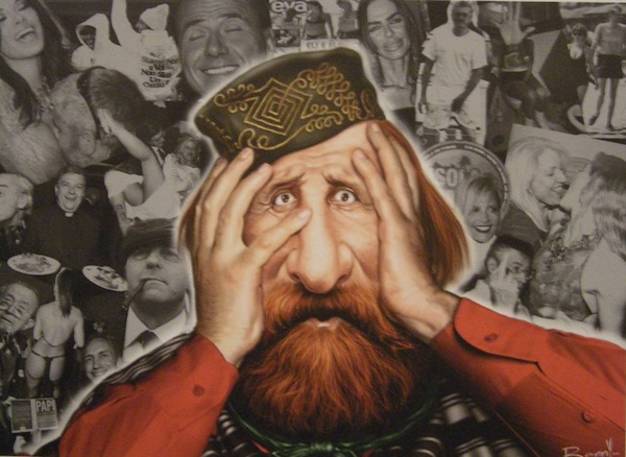


The exhibition 'Fratelli d'Italia', a collections of caricatures and artistic works on the theme of the Italian Unification, has arrived in New York. The works were selected by a competition organized by FASI, the Italian Federation of Sardinian Associations [2]. With a few exceptions, the prizes were sums of money which were divided in ten categories – such as 'satire', 'illustration', or a category dedicated only to Sardinia. New York University's Casa Italiana Zerilli-Marimò [3]will be displaying reproductions of the original works (on view in Cagliari) through July 30, 2011.
Prof. Davide Lombardo, a collaborator of NYU in Florence [4], is the curator of the exhibition. i-Italy had the opportunity of interviewing him.
According to which criteria were the works chosen?
The selection was made by a group of artists according to aesthetic qualities. The works were divided into sections, some of which had already been decided, such as the historical one and the Fratelli d'Italia theme one, and others resulted from the works themselves: 'How we are seen' is a section created after many works came from foreign artists; another unexpected category was 'Garibaldi' [5], who gained a lot of attention.
We received works from Australia, the Middle East, Eastern Europe and the Americas. 180 out of 480 artists were foreigners.
Which details of the Italian culture and history were chosen by the foreigners who participated?
Foreigners mainly reflected on contemporary Italy, with a knowledge of today's internal divisions. The second predominant elemnt in their works was the idea of Italy as a place of art.
As curator of this exhibit, what is your opinion of the series of events organized for Italy's 150th anniversary? They range from concerts to exhibits to lectures; do you think more emphasis was given to the past or do you believe that attention was given to contemporary Italy?
This year marks the third 'jubilee' for Italian history: in 1911, for the 50th anniversary, we pondered upon Italy becoming a great but still incomplete nation; for the 100th anniversary, in 1961, Italy was complete, as well as the Italians; the message for this 150th anniversary has not clearly emerged yet because of the strong internal division – there was a crisis even within the ufficial commission in 2010 which ended with Ciampi's resignation. I participated in the celebrations in Turin where it was decided to unite Italy's history with the country's projection toward a globalized future, but certainly we look at Italy's present and future with a little insecurity.
Do you believe that private proposals such as this exhibition can give a truer image of contemporary Italy, in respect to the institutional events?
First of all I was surprised by the Italian answer: on March 17, the streets were loaded with flags. Italians using the flag is very unusual, it only happens for the world cup, and yet people participated and felt this strongly, even with certain political readings. The answer of the artists is different: they tried to give an idea of the present and past to describe national identity; many represented the breaking of the symbols of unity, with images of torn flags, for example. Foreign artists mainly focused on the history of art.
We spoke to Elsa de Giovanni, the on-site coordinator at Casa Italiana.
How was this exhibit at Casa Italiana organized?
Two months ago we received the proposal and decided to accept it, since it fit in perfectly with the events dedicated to the 150th anniversary of the Unification, which we are dedicating a lot of attention to. We had very little time, but the collaboration with Prof. Lombardo worked perfectly. Usually, with exhibits, the most complicated aspect is dealing with the shipping of the works of art, but in this case we are displaying copies of the originals, that are being loaned to us, so there were no problems with customs.
What are the most important aspects of the exhibit?
It is an interactive and dynamic exhibition, because it came from a proposal of FASI that was answered by a huge number of artists. It is full of caricatures, drawings and isn't only limited to classic forms of artistic expression. These are all attractive and fun images, that obtain the interest of the public. We recorded a large participation of younger visitors, which is uncommon for these types of events. In this case, the exhibition stands out because it offers a new point of view for looking at Italy, comedy and satire. Also, it was great for the exhibit to be opened with the Italian national anthem that gives it its name.
Nothing is left except to go and see the exhibit at Casa Italiana Zerilli-Marimò.
Source URL: http://test.iitaly.org/magazine/events/reports/article/fratelli-ditalia-drawings-caricatures-people-and-their-history
Links
[1] http://test.iitaly.org/files/foto-garibaldi1307125842jpg
[2] http://www.fasi-italia.it/
[3] http://www.casaitaliananyu.org
[4] http://www.nyu.edu/global/global-academic-centers1/florence.html
[5] http://en.wikipedia.org/wiki/Giuseppe_Garibaldi